Power Control Optimization of an Underwater Piezoelectric Energy Harvester
Abstract
:1. Introduction
2. Harvester Description
3. Computational Setup
4. Computational Results
5. Harvester Control Modeling
5.1. Piezoelectric System
5.2. Hydro-Mechanical Model
5.3. Piezoelectric Power Control
6. Results
7. Conclusions
Supplementary Materials
Acknowledgments
Author Contributions
Conflicts of Interest
References
- Sreekanth, K.J.; Jayaraj, S.; Sudarsan, N. Economic Impact of CDM Implementation through Alternate Energy Resource Substitution. Int. J. Renew. Energy Dev. 2013, 2, 6. [Google Scholar] [CrossRef]
- Mishra, S.P.; Ali, S.M.; Pradhan, A.; Mohapatra, P.; Singh, V. Increasing energy efficiency in India by the use of green building. Int. J. Renew. Energy Technol. 2013, 4. [Google Scholar] [CrossRef]
- Daoutidis, P.; Zachar, M.; Jogwar, S.S. Sustainability and process control: A survey and perspective. J. Process Control 2016, 44, 184–206. [Google Scholar] [CrossRef]
- Parisio, A.; Rikos, E.; Glielmo, L. Stochastic model predictive control for economic/environmental operation management of microgrids: An experimental case study. J. Process Control 2016, 43, 24–37. [Google Scholar] [CrossRef]
- Lund, H.; Østergaard, P.A.; Connolly, D.; Ridjan, I.; Mathiesen, B.V.; Hvelplund, F.; Thellufsen, J.Z.; Sorknæs, P. Energy Storage and Smart Energy Systems. Int. J. Sustain. Energy Plan. Manag. 2016, 11. [Google Scholar] [CrossRef]
- Cottone, F.; Vocca, H.; Gammaitoni, L. Nonlinear Energy Harvesting. Phys. Rev. Lett. 2009, 102, 080601. [Google Scholar] [CrossRef] [PubMed]
- Bruno, N.M.; Ciocanel, C.; Feigenbaum, H.P.; Waldauer, A. A theoretical and experimental investigation of power harvesting using the NiMnGa martensite reorientation mechanism. Smart Mater. Struct. 2012, 21, 094018. [Google Scholar] [CrossRef]
- Farsangi, M.A.A.; Cottone, F.; Sayyaadi, H.; Zakerzadeh, M.R.; Orfei, F.; Gammaitoni, L. Energy harvesting from structural vibrations of magnetic shape memory alloys. Appl. Phys. Lett. 2017, 110, 103905. [Google Scholar] [CrossRef]
- Kurt, E. Harvester systems under the magnetic media. In Proceedings of the International Conference Nuclear Renewable Energy Resources, Istanbul, Turkey, 14–19 May 2010. [Google Scholar]
- Brunelli, D.; Moser, C.; Thiele, L.; Benini, L. Design of a Solar-Harvesting Circuit for Batteryless Embedded Systems. IEEE Trans. Circuits Syst. I Regul. Pap. 2009, 56, 2519–2528. [Google Scholar] [CrossRef]
- Dini, M.; Romani, A.; Filippi, M.; Bottarel, V.; Ricotti, G.; Tartagni, M. A Nanocurrent Power Management IC for Multiple Heterogeneous Energy Harvesting Sources. IEEE Trans. Power Electron. 2015, 30, 5665–5680. [Google Scholar] [CrossRef]
- Lopez-Lapena, O.; Penella, M.T.; Gasulla, M. A Closed-Loop Maximum Power Point Tracker for Subwatt Photovoltaic Panels. IEEE Trans. Ind. Electron. 2012, 59, 1588–1596. [Google Scholar] [CrossRef]
- Wu, Y.; Zuo, L.; Zhou, W.; Liang, C.; McCabe, M. Multi-source energy harvester for wildlife tracking. Act. Passiv. Smart Struct. Integr. Syst. 2014, 9057, 905704. [Google Scholar] [CrossRef]
- Zulueta, E.; Kurt, E.; Uzun, Y.; Lopez-Guede, J.M. Power control optimization of a new contactless piezoelectric harvester. Int. J. Hydrogen Energy 2017, 42, 18134–18144. [Google Scholar] [CrossRef]
- O’Donnell, R. Energy harvesting from human and machine motion for wireless electronic devices. Proc. IEEE 2008, 96, 1455–1456. [Google Scholar] [CrossRef]
- Kurt, E.; Cottone, F.; Uzun, Y.; Orfei, F.; Mattarelli, M.; Özhan, D. Design and implementation of a new contactless triple piezoelectrics wind energy harvester. Int. J. Hydrogen Energy 2017, 42, 17813–17822. [Google Scholar] [CrossRef]
- Nesarajah, M.; Frey, G. Optimized Design of Thermoelectric Energy Harvesting Systems for Waste Heat Recovery from Exhaust Pipes. Appl. Sci. Basel 2017, 7, 634. [Google Scholar] [CrossRef]
- Uzun, Y.; Kurt, E. The effect of periodic magnetic force on a piezoelectric energy harvester. Sens. Actuators A 2013, 192, 58–68. [Google Scholar] [CrossRef]
- Uzun, Y.; Kurt, E. Performance exploration of an energy harvester near the varying magnetic field of an operating induction motor. Energy Convers. Manag. 2013, 72, 156–162. [Google Scholar] [CrossRef]
- Qureshi, F.U.; Muhtaroglu, A.; Tuncay, K. Sensitivity Analysis for Piezoelectric Energy Harvester and Bluff Body Design toward Underwater Pipeline Monitoring. J. Energy Syst. 2017, 1, 10–20. [Google Scholar] [CrossRef]
- Bizon, N.; Tabatabaei, N.M.; Blaabjerg, F.; Kurt, E. Energy Harvesting and Energy Efficiency; Springer: Berlin, Germany, 2017. [Google Scholar]
- Kurt, E.; Uzun, Y.; Durmus, C. Power characteristics of a new contactless piezoelectric harvester. In Proceedings of the 2015 4th International Conference on Electric Power and Energy Conversion Systems (EPECS), Sharjah, UAE, 24–26 November 2015. [Google Scholar]
- Uzun, Y.; Kurt, E.; Hilal Kurt, H. Explorations of displacement and velocity nonlinearities and their effects to power of a magnetically-excited piezoelectric pendulum. Sens. Actuators A Phys. 2015, 224, 119–130. [Google Scholar] [CrossRef]
- Frizzell, R.; Kelly, G.; Cottone, F.; Boco, E.; Nico, V.; O’Donoghue, D.; Punch, J. Experimental characterisation of dual-mass vibration energy harvesters employing velocity amplification. J. Intell. Mater. Syst. Struct. 2016, 27, 2810–2826. [Google Scholar] [CrossRef]
- Cottone, F.; Basset, P.; Guillemet, R.; Galayko, D.; Marty, F.; Bourouina, T. Bistable Multiple-Mass Elecrostatic Generator for Low-Frequency Vibration Energy Harvesting. In Proceedings of the 26th IEEE International Conference on Micro Electro Mechanical Systems (Mems 2013), Taipei, Taiwan, 20–24 January 2013; pp. 861–864. [Google Scholar]
- Cottone, F.; Frizzell, R.; Goyal, S.; Kelly, G.; Punch, J. Enhanced vibrational energy harvester based on velocity amplification. J. Intell. Mater. Syst. Struct. 2014, 25, 443–451. [Google Scholar] [CrossRef]
- Dong, D.; Chen, W.; Shi, S. Coupling Motion and Energy Harvesting of Two Side-by-Side Flexible Plates in a 3D Uniform Flow. Appl. Sci. Basel 2016, 6, 141. [Google Scholar] [CrossRef]
- Patel, I.; Siores, E.; Shah, T. Utilisation of smart polymers and ceramic based piezoelectric materials for scavenging wasted energy. Sens. Actuators A 2010, 159, 213–218. [Google Scholar] [CrossRef]
- Westwood, A. Materials for Advanced Studies and Devices. Metall. Mater. Trans. A 1988, 19, 749–758. [Google Scholar] [CrossRef]
- Taylor, G.; Burns, J.; Kammann, S.; Powers, W.; Welsh, T. The energy harvesting Eel: A small subsurface ocean/river power generator. IEEE J. Ocean. Eng. 2001, 26, 539–547. [Google Scholar] [CrossRef]
- Wang, D.; Chiu, C. Huy-Tuan Pham Electromagnetic energy harvesting from vibrations induced by Karman vortex street. Mechatronics 2012, 22, 746–756. [Google Scholar] [CrossRef]
- Wang, D.; Chao, C.; Chen, J. A miniature hydro-energy generator based on pressure fluctuation in Karman vortex street. J. Intell. Mater. Syst. Struct. 2013, 24, 612–626. [Google Scholar] [CrossRef]
- Tam Nguyen, H.-D.; Pham, H.-T.; Wang, D.-A. A miniature pneumatic energy generator using Karman vortex street. J. Wind Eng. Ind. Aerodyn. 2013, 116, 40–48. [Google Scholar] [CrossRef]
- Sarpkaya, T. A critical review of the intrinsic nature of vortex-induced vibrations. J. Fluids Struct. 2004, 19, 389–447. [Google Scholar] [CrossRef]
- Shan, X.; Song, R.; Liu, B.; Xie, T. Novel energy harvesting: A macro fiber composite piezoelectric energy harvester in the water vortex. Ceram. Int. 2015, 41, S763–S767. [Google Scholar] [CrossRef]
- Weinstein, L.A.; Cacan, M.R.; So, P.M.; Wright, P.K. Vortex shedding induced energy harvesting from piezoelectric materials in heating, ventilation and air conditioning flows. Smart Mater. Struct. 2012, 21, 045003. [Google Scholar] [CrossRef]
- Gammaitoni, L. There’s plenty of energy at the bottom (micro and nano scale nonlinear noise harvesting). Contemp. Phys. 2012, 53, 119–135. [Google Scholar] [CrossRef]
- Priya, S.; Inman, D.J. Energy Harvesting Technologies; Springer: Berlin, Germany, 2009; p. 517. [Google Scholar]
- Ronkanen, P.; Kallio, P.; Vilkko, M.; Koivo, H.N. Displacement Control of Piezoelectric Actuators Using Current and Voltage. IEEE-ASME Trans. Mechatron. 2011, 16, 160–166. [Google Scholar] [CrossRef]
- Cottone, F.; Goyal, S.; Punch, J. Energy Harvester Apparatus Having Improved Efficiency. U.S. Patent 20110074162 A1, 30 September 2009. [Google Scholar]
- STAR-CCM+ v.11.06 User’s Guide. Available online: https://www.sharcnet.ca/help/index.php/STAR-CCM+ (accessed on 21 September 2017).
- Osher, S.; Chakravarthy, S. Upwind Schemes and Boundary-Conditions with Applications to Euler Equations in General Geometries. J. Comput. Phys. 1983, 50, 447–481. [Google Scholar] [CrossRef]
- Menter, F.R. 2-Equation Eddy-Viscosity Turbulence Models for Engineering Applications. AIAA J. 1994, 32, 1598–1605. [Google Scholar] [CrossRef]
- Rahman, M.; Karim, M.; Alim, A. Numerical investigation of unsteady flow past a circular cylinder using 2-D finite volume method. J. Nav. Archit. Mar. Eng. 2007, 4, 27–42. [Google Scholar] [CrossRef]
- Rajani, B.N.; Kandasamy, A.; Majumdar, S. Numerical simulation of laminar flow past a circular cylinder. Appl. Math. Model. 2009, 33, 1228–1247. [Google Scholar] [CrossRef]
- Roshko, A. Vortex Shedding from Circular Cylinder at Low Reynolds Number; NACA Report No. 1191; Cambridge University Press: Cambridge, UK, 1954. [Google Scholar]
- Norberg, C. Flow around a circular cylinder: Aspects of fluctuating lift. J. Fluids Struct. 2001, 15, 459–469. [Google Scholar] [CrossRef]
- Tripathi, D. Practical Guide to Polypropylene; Rapra Technology LTD.: Shawbury, Shropshire, UK, 2002. [Google Scholar]
- Maier, C.; Calafut, T. Polypropylene: The Definitive User’s Guide and Databook; William Andrew: Norwich, NY, USA, 1998. [Google Scholar]
- Atluri, S.; Rao, V.K.; Dalton, C. A numerical investigation of the near-wake structure in the variable frequency forced oscillation of a circular cylinder. J. Fluids Struct. 2009, 25, 229–244. [Google Scholar] [CrossRef]
- Song, R.; Shan, X.; Lv, F.; Li, J.; Xie, T. A Novel Piezoelectric Energy Harvester Using the Macro Fiber Composite Cantilever with a Bicylinder in Water. Appl. Sci. Basel 2015, 5, 1942–1954. [Google Scholar] [CrossRef]
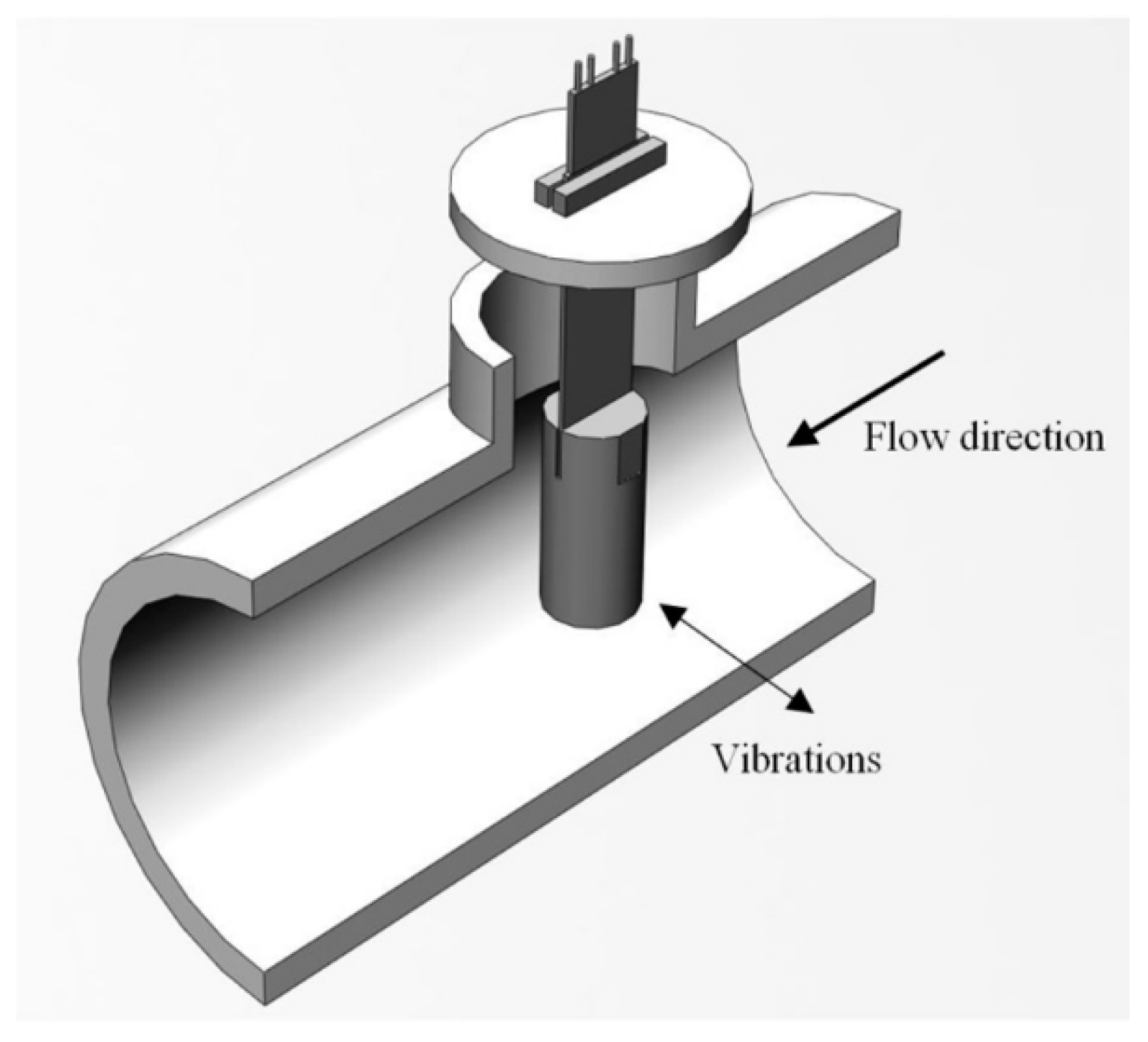
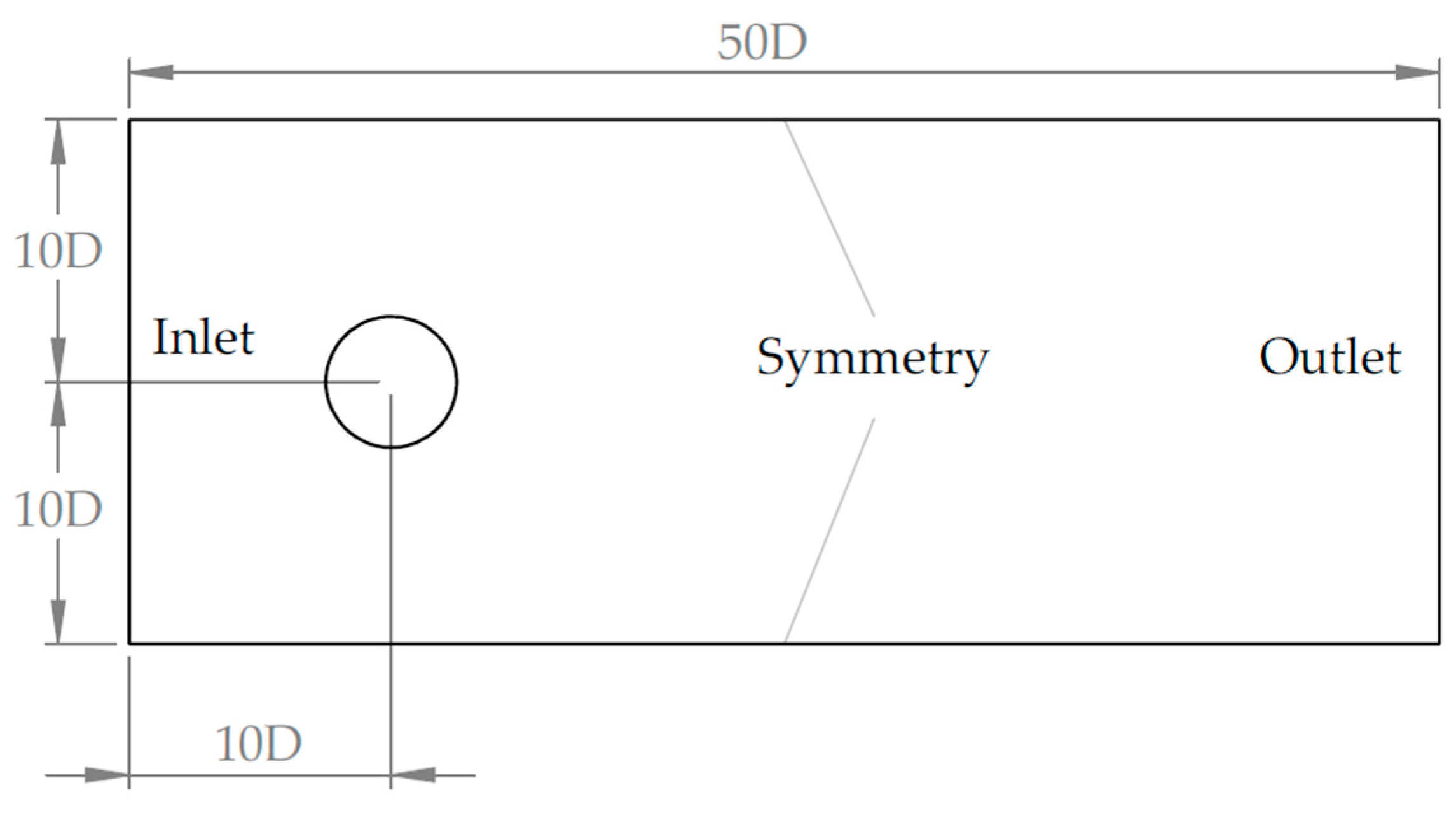
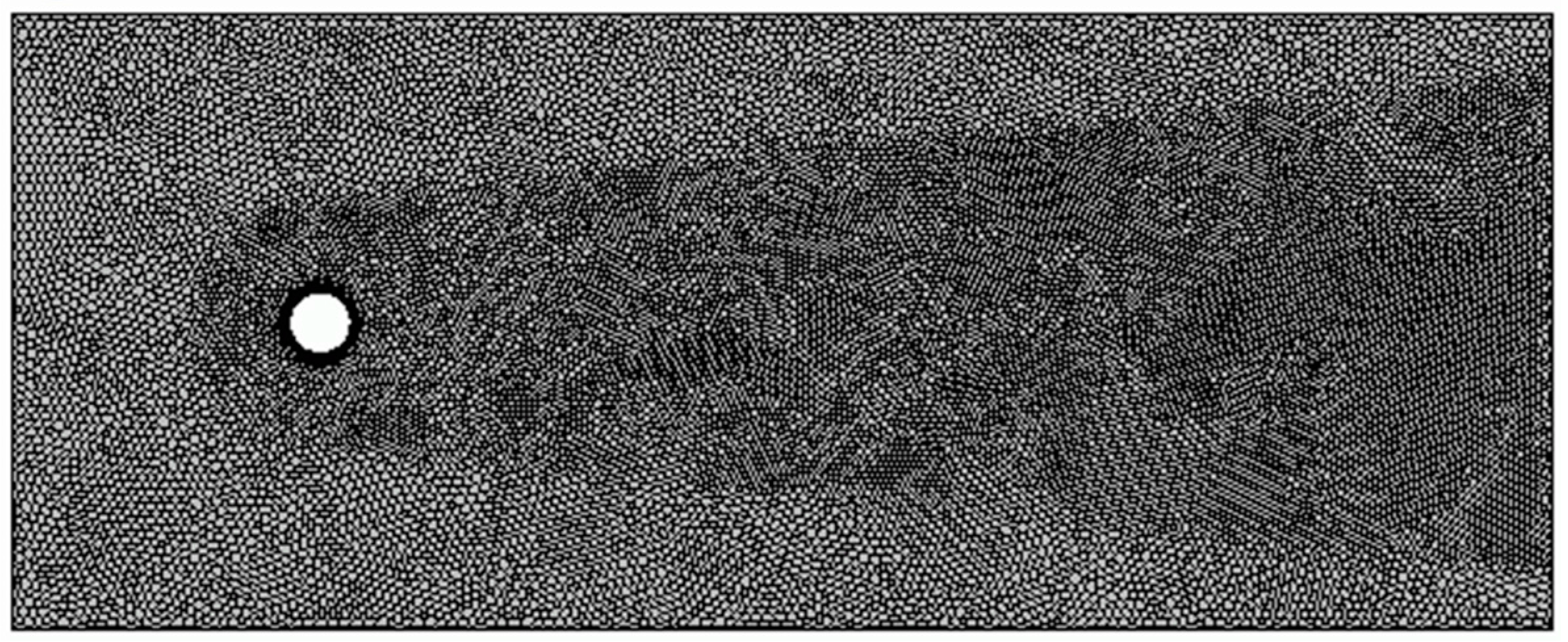
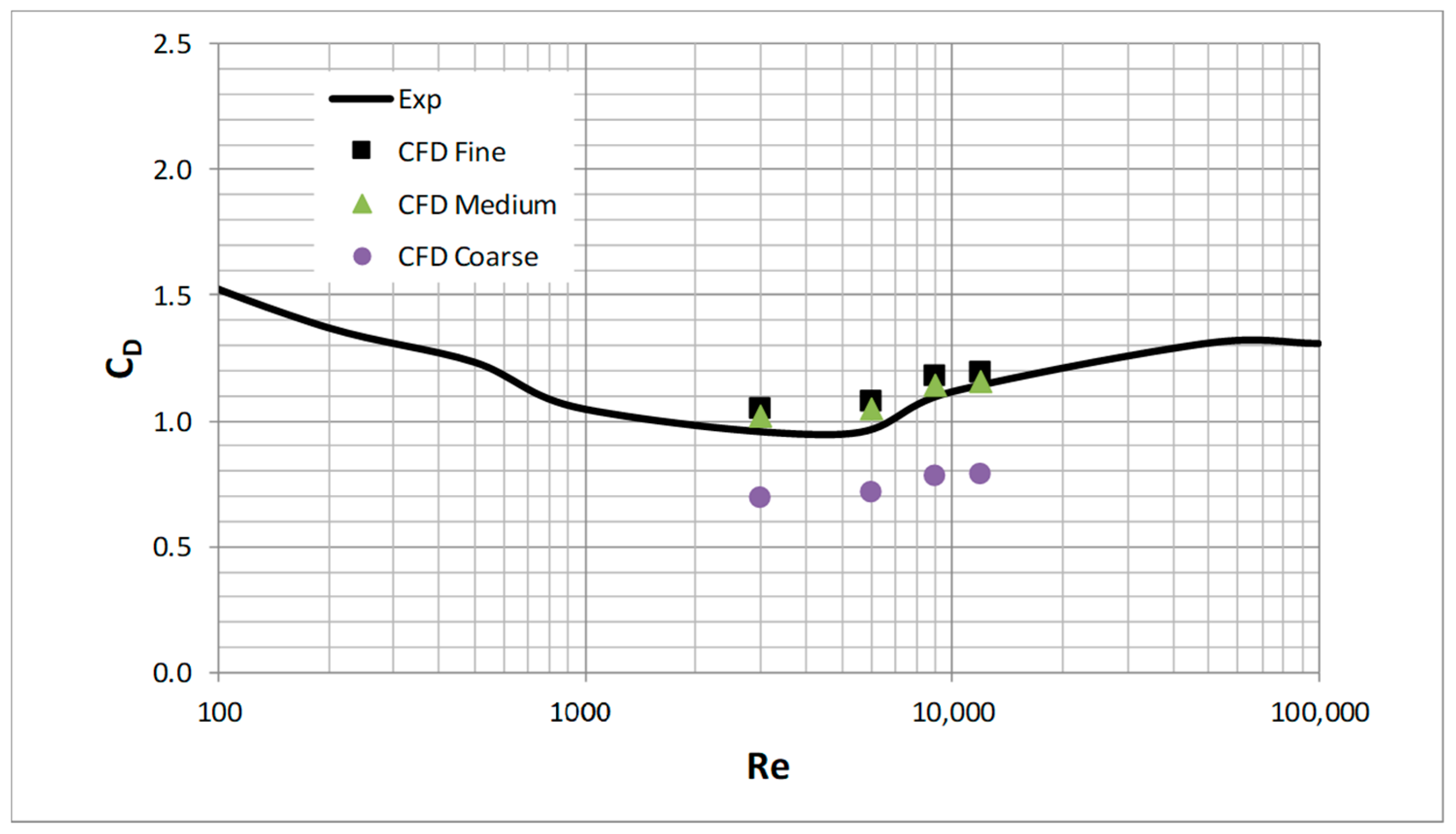
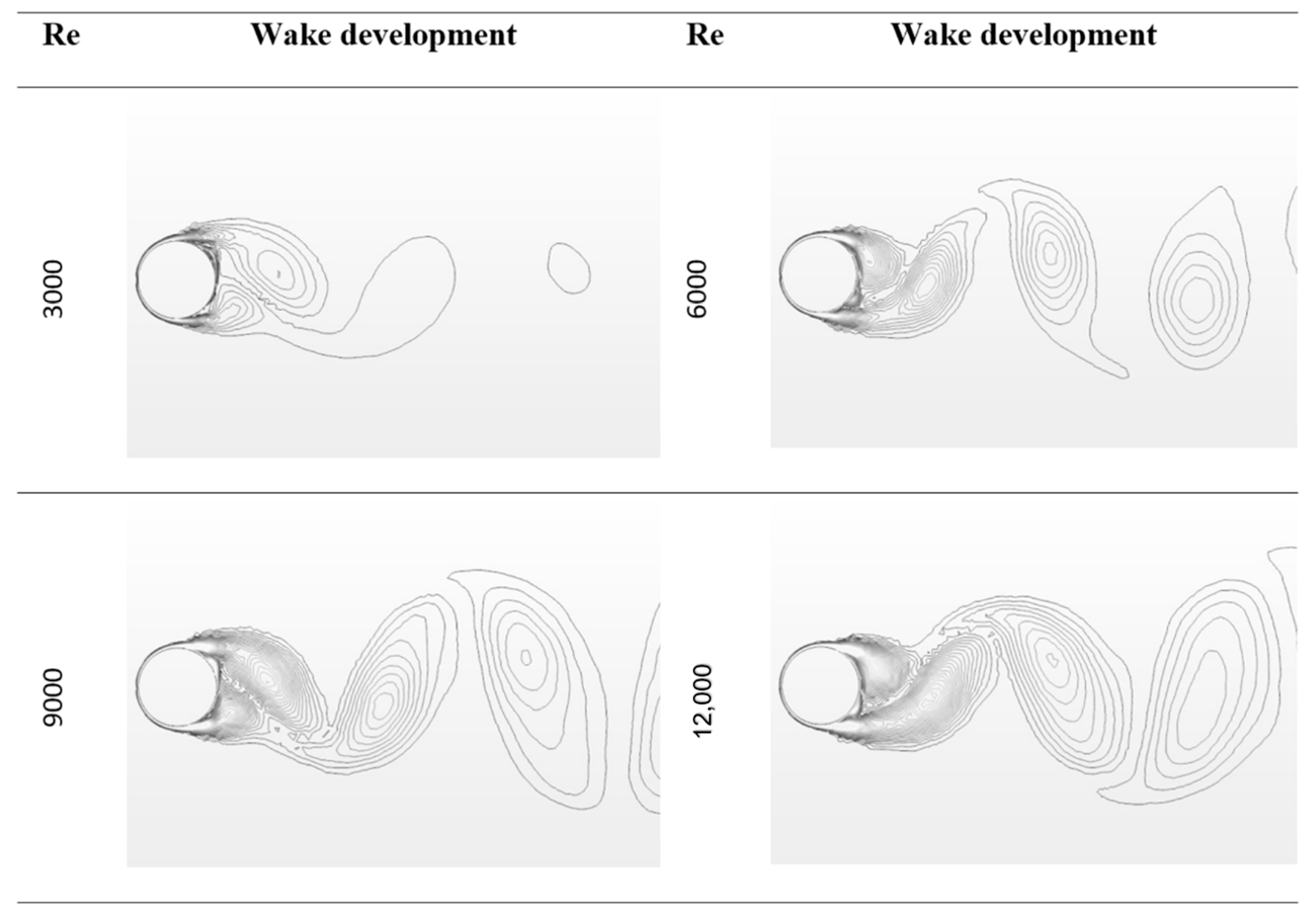
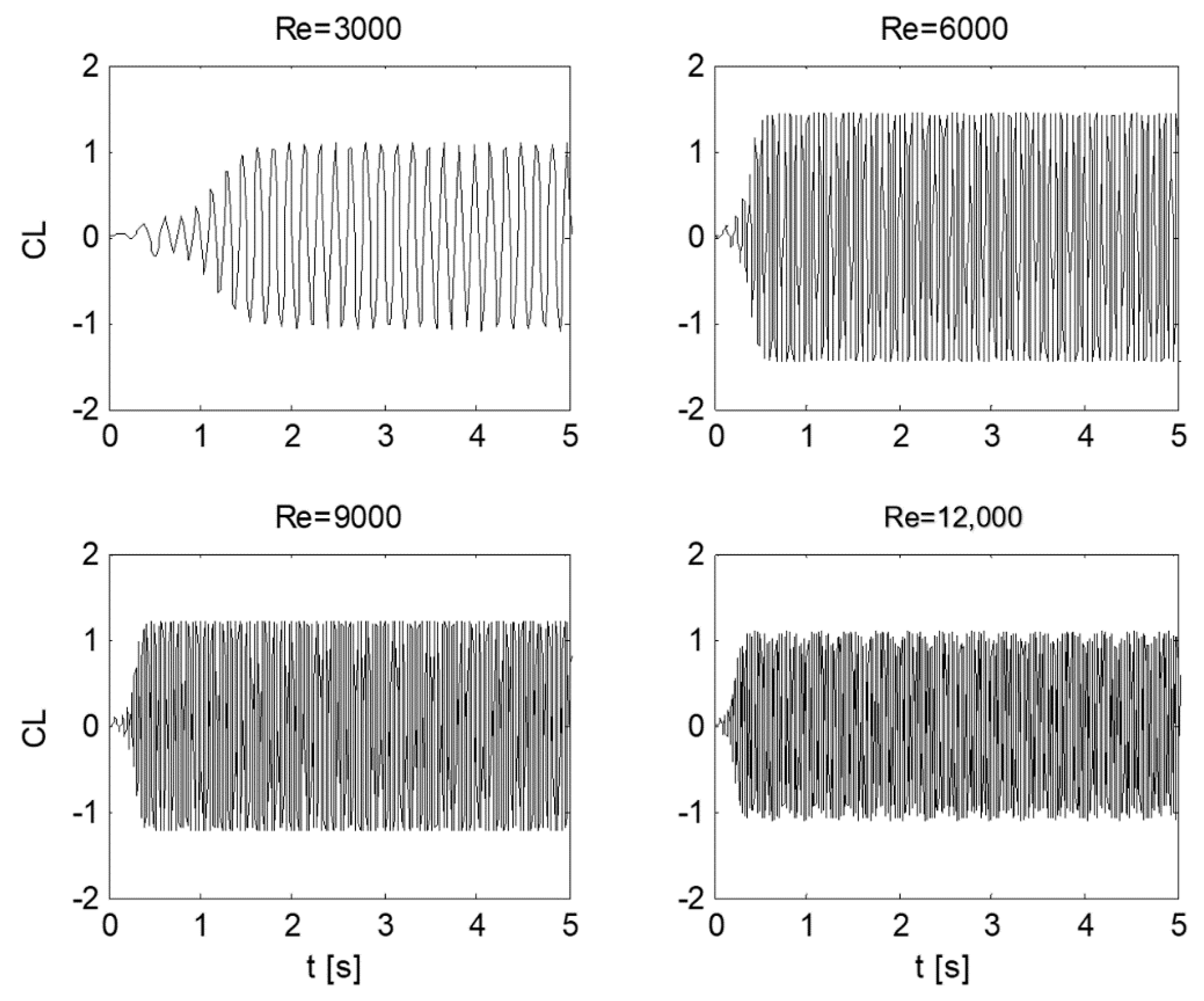
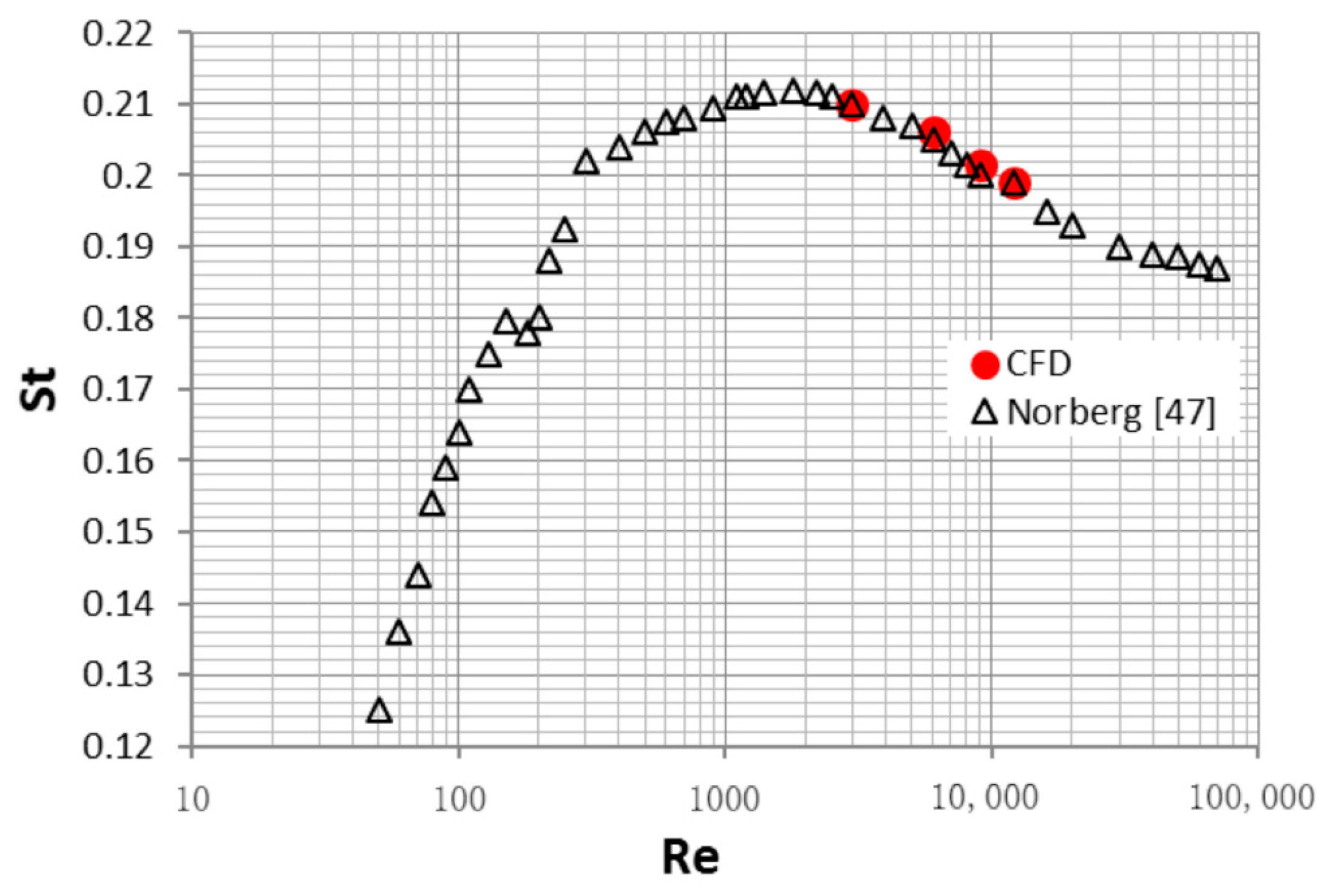
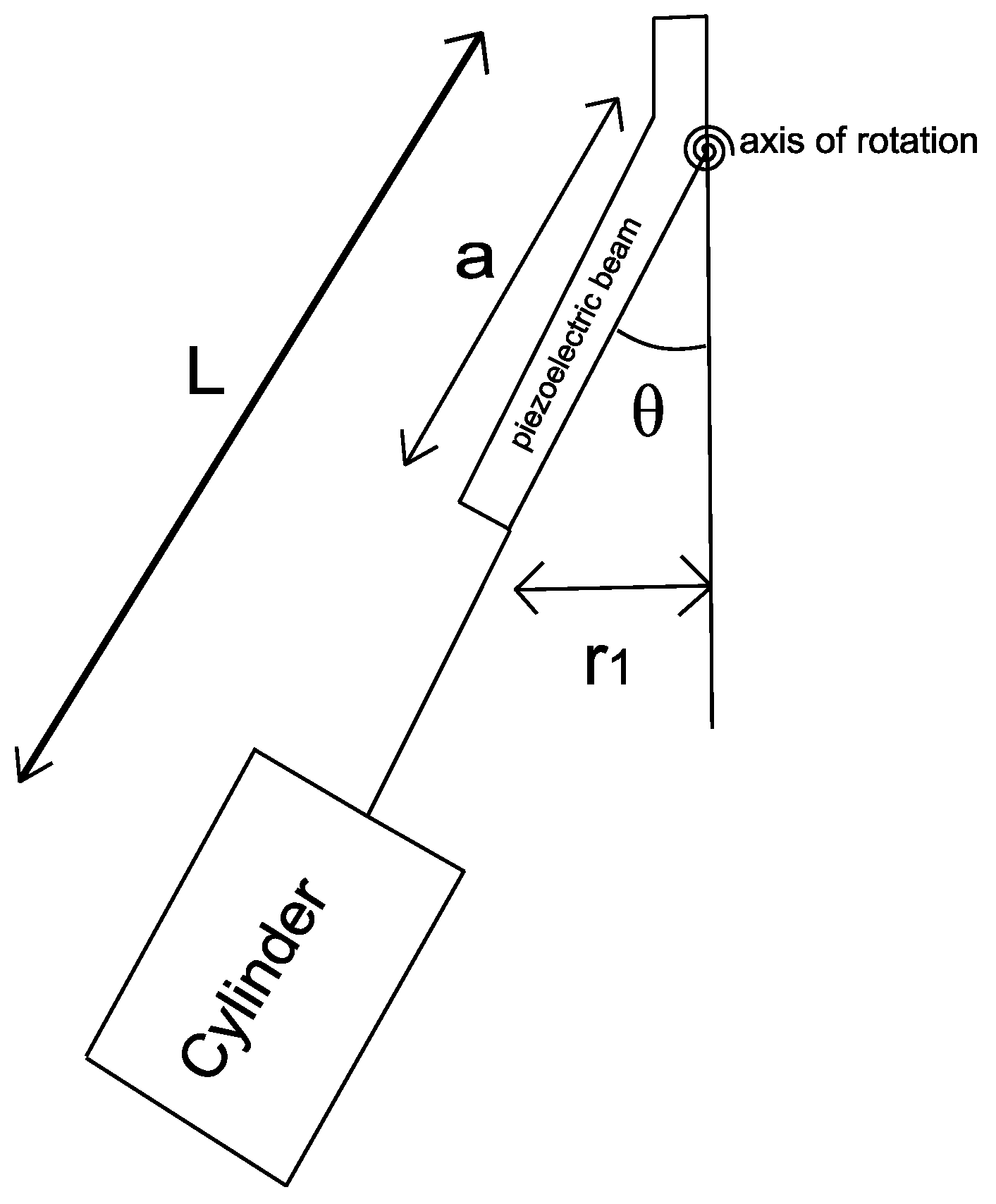
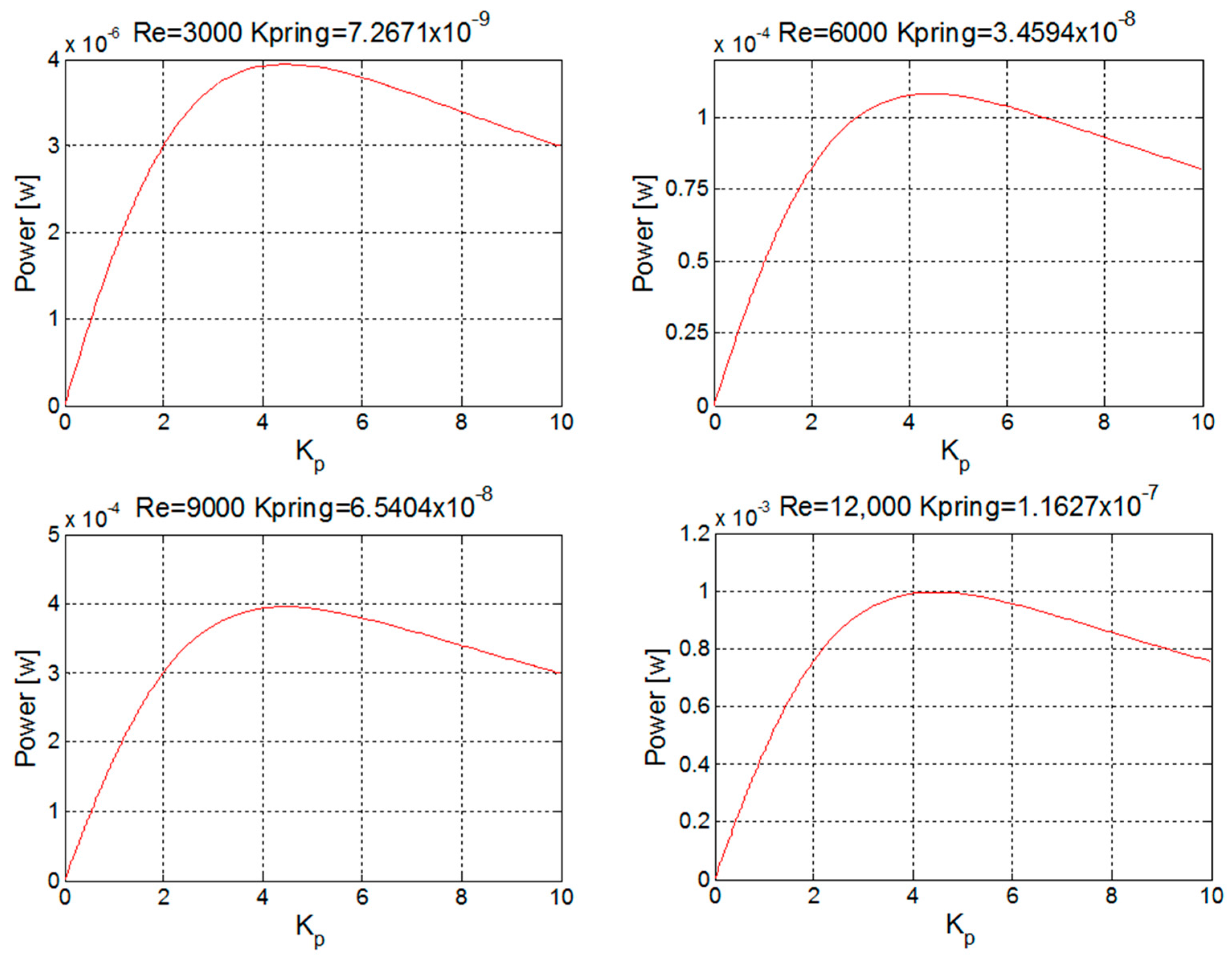
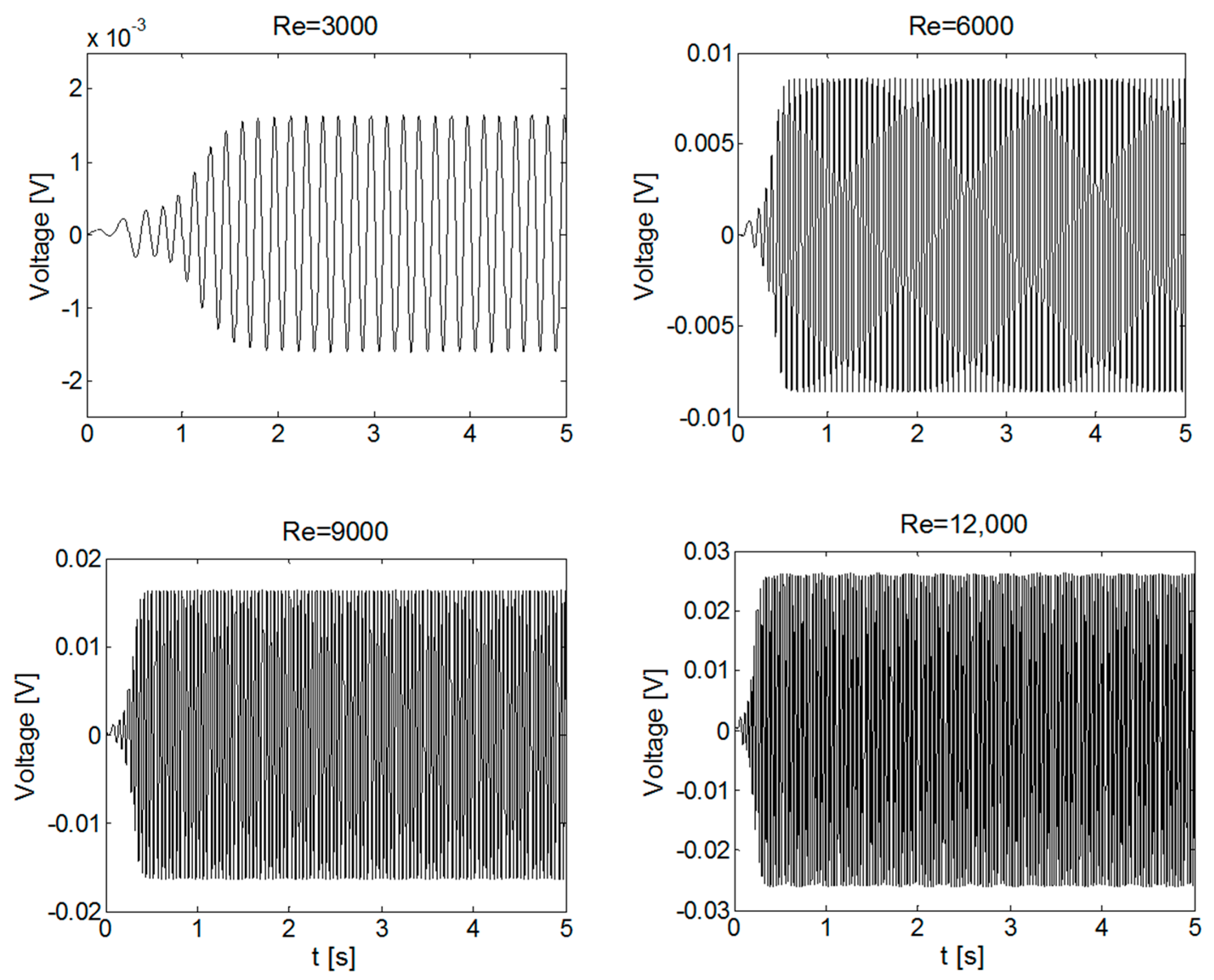
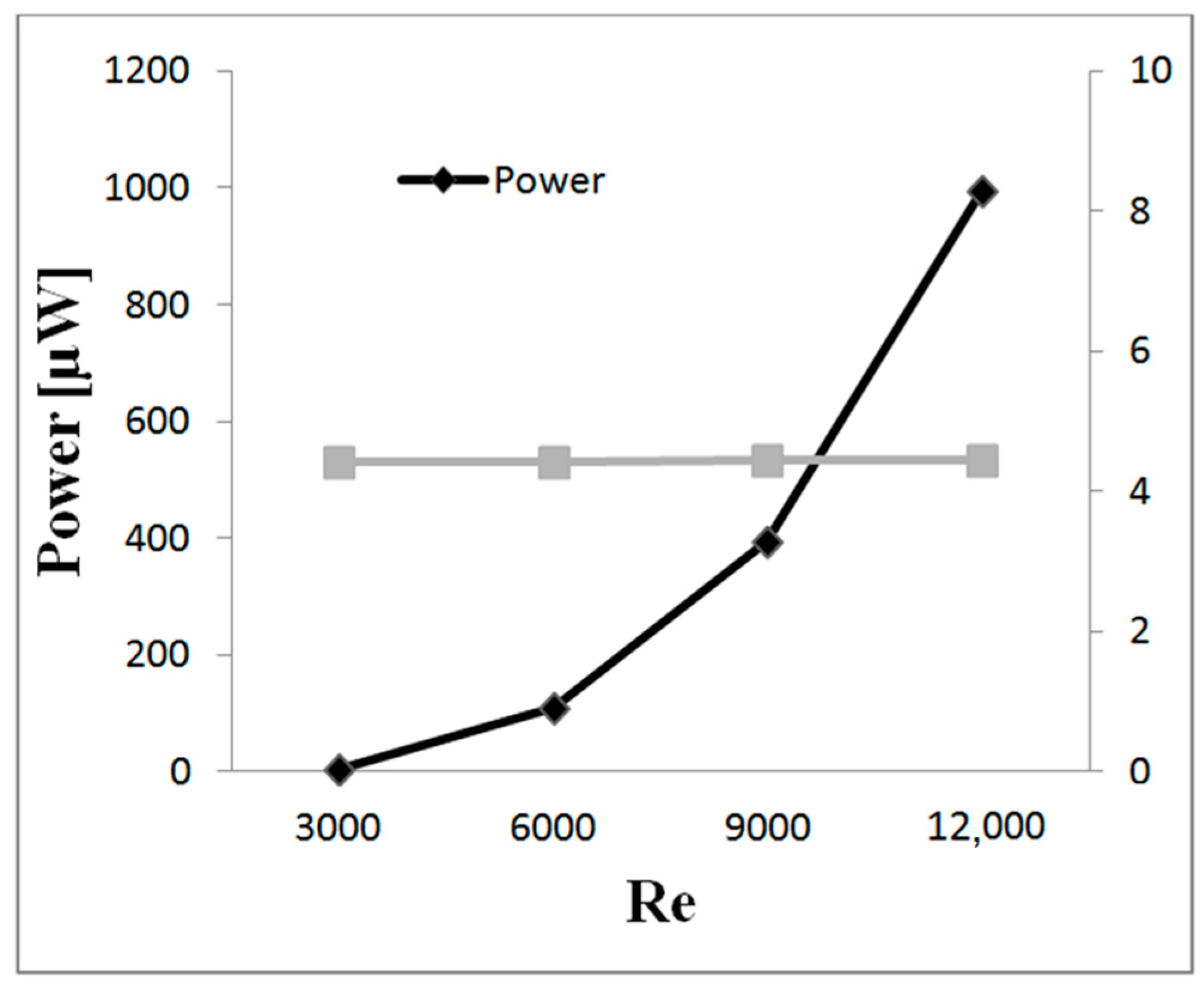
| Mesh | Richardson Extrapolation | |||||
|---|---|---|---|---|---|---|
| Re | Coarse | Medium | Fine | RE | p | R |
| 3000 | 0.69 | 1.02 | 1.05 | 1.05 | 3.46 | 0.09 |
| 6000 | 0.71 | 1.05 | 1.08 | 1.08 | 3.37 | 0.10 |
| 9000 | 0.78 | 1.14 | 1.18 | 1.18 | 3.34 | 0.10 |
| 12,000 | 0.79 | 1.15 | 1.19 | 1.19 | 3.35 | 0.10 |
| Name | Definition | Value | Units |
|---|---|---|---|
| Piezoelectric Material density | 5319 | kg/m3 | |
| Circular cylinder Material density | 920 | kg/m3 | |
| Fluid density | 997.5 | kg/m3 | |
| A | Section of piezoelectric | 0.01 | m2 |
| k | Piezoelectric stiffness | 123 | N/m |
| Ktrans | Transduction gain | 2 | - |
| C | Piezoelectric Capacitance | 1 | nF |
| Frictional coefficient | 0.01 | (N·m·s)/rad | |
| L1 | Length of layer | 0.0035 | m |
| L | Radius of gyration | 0.08 | m |
| Ha | Cylinder height | 0.05 | m |
| a | Force application distance point | 0.01 | m |
| α | Voltage induced bending factor | 100 | A·s/m |
| Jwt | Cylinder inertia moment | 4.2 × 10−7 | kg·m2 |
| Name | Definition | Units |
|---|---|---|
| CL,max | Maximum lift coefficient | - |
| V | Piezoelectric voltage | V |
| i | Piezoelectric current | A |
| t | Time | s |
| θ | Beam angle | rad |
| Vwater | Water speed | m/s |
| Rotational speed | rad/s | |
| Spring constant | - | |
| Proportional gain | A/V | |
| Tm | Moment generated by the piezoelectric | Nm |
| Fm | Piezoelectric force | N |
| Angular pulsation of the lift coefficient | rad/s | |
| r1 | Piezoelectric beam tip deflection | m |
| u1 | Reference of the piezoelectric deflection | m |
| Re | Vwater (m/s) | Power µW | Kp (Optimal) | Kspring (Optimal) |
|---|---|---|---|---|
| 3000 | 0.34 | 3.95 | 4.412 | 7.2671 × 10−9 |
| 6000 | 0.68 | 108.15 | 4.419 | 3.4594 × 10−8 |
| 9000 | 1.02 | 395.12 | 4.459 | 6.5404 × 10−8 |
| 12,000 | 1.36 | 996.25 | 4.452 | 1.1627 × 10−7 |
© 2018 by the authors. Licensee MDPI, Basel, Switzerland. This article is an open access article distributed under the terms and conditions of the Creative Commons Attribution (CC BY) license (http://creativecommons.org/licenses/by/4.0/).
Share and Cite
Aramendia, I.; Fernandez-Gamiz, U.; Zulueta Guerrero, E.; Lopez-Guede, J.M.; Sancho, J. Power Control Optimization of an Underwater Piezoelectric Energy Harvester. Appl. Sci. 2018, 8, 389. https://doi.org/10.3390/app8030389
Aramendia I, Fernandez-Gamiz U, Zulueta Guerrero E, Lopez-Guede JM, Sancho J. Power Control Optimization of an Underwater Piezoelectric Energy Harvester. Applied Sciences. 2018; 8(3):389. https://doi.org/10.3390/app8030389
Chicago/Turabian StyleAramendia, Iñigo, Unai Fernandez-Gamiz, Ekaitz Zulueta Guerrero, Jose Manuel Lopez-Guede, and Javier Sancho. 2018. "Power Control Optimization of an Underwater Piezoelectric Energy Harvester" Applied Sciences 8, no. 3: 389. https://doi.org/10.3390/app8030389






